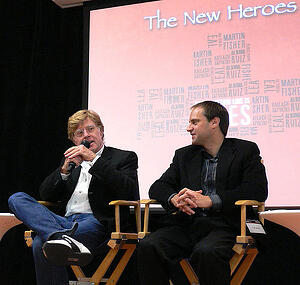How do kids begin the process of choosing a college major? For some it’s an easy decision. Often, it starts with a specific interest or maybe they are exceptional in a particular subject. I remember in high school completing some sort of career questionnaire. It said my interests would align with communications or public relations. I figured, great! I like people and I like to talk. For me, communications was a great fit, but looking back, I do wish I had done more research about career paths for my major.
Kids today have access to so much more information. College majors seem more defined and specialized now. When I went to college, I went in thinking I had at least two years to figure out my major. Many students now declare their major during the college admissions process. But how does an 18 year old really know what they want to do? How do they figure out all the potential careers one major can offer?
One way to help them figure it out is to volunteer. Community engagement can provide high school and college students with an opportunity to explore their interests or try something new.
“Kids who do community service see how they can apply their skills in different areas,” said Dan Van Dyke, a high school counselor for De La Salle Institute in Chicago, IL.
 Van Dyke said when he asks students why they want to pursue a specific major; they usually reply that they are good in that subject. For example, a student good in Math wants to study Engineering, but he may not look further than the obvious career path. They don’t think about all the different options for their particular set of skills. Many students just don’t want to do the research.
Van Dyke said when he asks students why they want to pursue a specific major; they usually reply that they are good in that subject. For example, a student good in Math wants to study Engineering, but he may not look further than the obvious career path. They don’t think about all the different options for their particular set of skills. Many students just don’t want to do the research.
However, Van Dyke said students who perform community service seem to have a better idea of what majors they want to pursue and will research them as part of their college admissions process. “I’ve seen kids who work at the Greater Chicago Food Depository or help the homeless, and they become interested in public policy or social work. They want to know how they can use their talents for social good. They are more motivated to do research about colleges and majors because they are exposed to different career options.”
Van Dyke has also seen students avoid certain majors because they don’t think it will lead to a career with a lucrative salary. Through student volunteering, they realize there are other rewards for specific careers. “Students that do community service with kids, come back with a feeling of accomplishment. They can see that they can make a difference and it’s very rewarding.”
Jennifer Walker, Director of Programs for Madison House, the student volunteer center at the University of Virginia, has seen similar circumstances with college students. “Some of our students want to pursue volunteering that is in their professional field of interest. For example, prospective teachers may want to get a better sense of what it is like to be in the classroom before they apply to graduate programs for teaching.”
For Allison and Sally-Rose Cragin, volunteering has always been a family affair. Their mom, Louise, instilled a love of helping others at an early age by encouraging them to volunteer at Krewe de Camp, an annual, one-week camp for children with special needs in Covington, Louisiana.
 Allison’s volunteer work at the camp and throughout high school not only confirmed her desire to work in medicine, but also influenced her decision to become a pediatrician. A 2012 graduate of Louisiana State University School of Medicine, Allison is currently in the UAB Pediatrics Residency Program, and continues to volunteer. “I was always interested in becoming a doctor, but I thought I would pursue surgery or research,” said Cragin. “Now I hope to be a pediatrician for children with special healthcare needs. The projects I did in college were definitely geared toward my interest in medicine.”
Allison’s volunteer work at the camp and throughout high school not only confirmed her desire to work in medicine, but also influenced her decision to become a pediatrician. A 2012 graduate of Louisiana State University School of Medicine, Allison is currently in the UAB Pediatrics Residency Program, and continues to volunteer. “I was always interested in becoming a doctor, but I thought I would pursue surgery or research,” said Cragin. “Now I hope to be a pediatrician for children with special healthcare needs. The projects I did in college were definitely geared toward my interest in medicine.”
Sally-Rose’s decision to pursue her major was also a direct result of her experiences volunteering at Krewe de Camp. She is a junior at Rochester Institute of Technology studying American Sign Language Interpreter Education.
 “Every year, since before I can remember, my mom brought me to help her at Krewe de Camp. When I was 8 years old, I met a girl named Katie who had Cerebral Palsy. She couldn't use her voice to speak so she used sign language. As soon as camp was over I asked my mom for some sign language books and dictionaries so I could learn how to communicate with Katie for the next summer. I can trace back my decision to go to RIT for interpreting to that day. I loved the feeling of being able to communicate with someone through a visual language and I wanted to be able to facilitate communication between people like Katie and other people who don't know her language.”
“Every year, since before I can remember, my mom brought me to help her at Krewe de Camp. When I was 8 years old, I met a girl named Katie who had Cerebral Palsy. She couldn't use her voice to speak so she used sign language. As soon as camp was over I asked my mom for some sign language books and dictionaries so I could learn how to communicate with Katie for the next summer. I can trace back my decision to go to RIT for interpreting to that day. I loved the feeling of being able to communicate with someone through a visual language and I wanted to be able to facilitate communication between people like Katie and other people who don't know her language.”
Sally-Rose said her favorite part of high school was the community service work she was able to do during high school with Boys Hope Girls Hope of New Orleans and summer camps like Camp Sertoma and Meadowood Springs Speech and Hearing Camp.
“When I graduate in May of 2015, I would love to do Educational Interpreting in some of the younger grades. I would really like to go to graduate school for a Masters Degree in Special Education with a focus in Deaf Education.”
 Walker thinks it’s never too soon to begin student volunteering in the community. “It can provide an easy and free way for students to get an idea about their potential career path.”
Walker thinks it’s never too soon to begin student volunteering in the community. “It can provide an easy and free way for students to get an idea about their potential career path.”
What are your children’s interests? Are they volunteering in areas they want to study in college? Not sure where to start, check out our guide to volunteering.


 members against bullying. They started and have been celebrating National Bullying Prevention Month each October since 2006, and in 2011 created
members against bullying. They started and have been celebrating National Bullying Prevention Month each October since 2006, and in 2011 created 







 8. Visit Nursing Homes: Visit the elderly and keep them company by reading books, playing games, or just chatting for a while. Help host events and activities. Tech-savvy teens can help someone connect with email or social networking to keep in touch with distant relatives. Just spending some time with a senior citizen can brighten his or her day and yours too. You’ll make new friends and hear stories outside the texting and tweeting generation.
8. Visit Nursing Homes: Visit the elderly and keep them company by reading books, playing games, or just chatting for a while. Help host events and activities. Tech-savvy teens can help someone connect with email or social networking to keep in touch with distant relatives. Just spending some time with a senior citizen can brighten his or her day and yours too. You’ll make new friends and hear stories outside the texting and tweeting generation. 
 Critics would also challenge the amount of money being put into volunteerism abroad. With the hundreds and thousands of dollars people spend for their travel and accommodations while volunteering, many warn against “the dark side of our desire to help the developing world” as put by Ian Birrel in his article “Before you pay to volunteer abroad, think of the harm you might do”. Birrel warns that “orphanages are a booming business trading on guilt [. . .] Those ‘orphans’ might have been bought from impoverished parents [. . . ]An official study found just a quarter of children in these so-called orphanages have actually lost both parents. And these private ventures are proliferating fast.” The trouble with so many more tourists wanting to enrich their vacations with volunteering is that it becomes a disturbing industry where locals can profit on Westerners’ consciences. Thousands of organizations encourage people to volunteer with their organization, but often these short excursions do more harm for local communities in the developing world. They take away jobs from skilled locals and give them to volunteers who will pay to work there. Often the money spent by volunteers to travel abroad would be better used cultivating new industries and building infrastructure to help developing nations grow, rather than keeping them dependent on the developed world.
Critics would also challenge the amount of money being put into volunteerism abroad. With the hundreds and thousands of dollars people spend for their travel and accommodations while volunteering, many warn against “the dark side of our desire to help the developing world” as put by Ian Birrel in his article “Before you pay to volunteer abroad, think of the harm you might do”. Birrel warns that “orphanages are a booming business trading on guilt [. . .] Those ‘orphans’ might have been bought from impoverished parents [. . . ]An official study found just a quarter of children in these so-called orphanages have actually lost both parents. And these private ventures are proliferating fast.” The trouble with so many more tourists wanting to enrich their vacations with volunteering is that it becomes a disturbing industry where locals can profit on Westerners’ consciences. Thousands of organizations encourage people to volunteer with their organization, but often these short excursions do more harm for local communities in the developing world. They take away jobs from skilled locals and give them to volunteers who will pay to work there. Often the money spent by volunteers to travel abroad would be better used cultivating new industries and building infrastructure to help developing nations grow, rather than keeping them dependent on the developed world.



